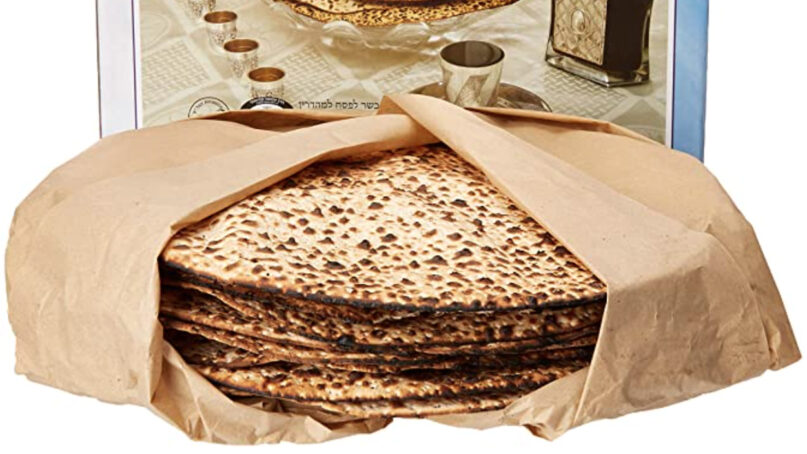(RNS) — When my family sits at the Passover Seder table this weekend, it will be the first time in many years when my wife and I will not be among the hosts. (Nor will we be in Israel, where, with all respect to our hosts, I’d really prefer.) Several days ago we got a note assigning us homework at one Seder: In addition to our assigned readings from the Haggadah, the traditional Passover liturgy, we were asked to be ready to speak, read or sing about a topic chosen from a list that followed.
Most of the meditations were on the usual items on the Seder menu: bitter herbs, matzah, haroseth, 4 cups of wine and roasted egg. But also on the list were the elements of the Passover story: Elijah, 10 plagues, Pharaoh, four sons (or children). Also: slavery, freedom, redemption and Dayenu, the 1,000-year-old song traditionally sung at Seder, which translates to “It would have been enough.” Indeed, it will have been enough.
My wife chose freedom; I immediately chose matzah.
I truly love matzah. Plain Passover matzah. Matzah brei (“fried matzah” as it was known well in my house). And many a simple but large sandwich with cream cheese and jelly have been a holiday staple for me since childhood.
RELATED: The Passover meal has already made room for vegan entrees. Next up? Cell-based meat
To each of the two Seders we will gratefully attend this year we will be bringing homemade chopped liver (chicken and a little beef, combined with minced onion and, naturally, schmaltz — rendered chicken fat), a fancy dessert from our own kitchen (with of course no flour, leavening nor even milk, so as to not combine dairy and meat), a very nice bottle of a new Israeli wine and a somewhat rare box of Ukrainian-made shmurah matzah.
Rare, because it turns out there may be a shortage of shmurah matzah this year. Shmurah is matzah that is handmade with wheat and in a bakery that has been meticulously inspected (“shmurah” literally means watched, but “guarded” fits better and has the same Hebrew root) to prevent any kind of contamination that might render the bread no longer strictly — strictly! — kosher. Particularly from even the slightest bit of moisture. And this, from the first moment of wheat harvesting.
Shmurah is mostly made round in shape (instead of machine-made square), in an attempt to further replicate the matzah that Scripture teaches us the Israelites made and ate on their hasty exodus from biblical Egypt.
At a minimum, the taste is authentic. A favorite observation of mine is that shmurah matzah tastes little different from the box it comes in.

Boxed Holyland Shmura Matzo for sale. Courtesy photo
But shmurah matzah is especially precious because it would have disappeared from Jewish culture had it not been for a campaign launched in 1954 by the Lubavitcher Rebbe, Menachem Mendel Schneerson, to encourage its use at Seder. It’s now clearly having a renaissance. A recent survey found that perhaps 1 million pounds of shmurah will be produced in the U.S. alone this year.
For two decades, I regularly got my own shmurah matzah from my good friend and local head Chabad-Lubavitch sh’liach, or emissary, Rabbi Levi Shemtov. Then, a few years ago, I saw that shmurah — and maybe Chabad with it — had finally and fully arrived in popular culture when my favorite Costco had literally hundreds and hundreds of boxes of it for sale just before the holiday. Shmurah! In Costco!
But I still get mine from Chabad.
This year my shmurah matzah will be particularly precious. Much of shmurah matzah on sale in the United States comes from Ukraine, the commodity’s biggest exporter after Israel. Some 180,000 pounds of matzah shipped to America this year was baked there, mostly in Dnipro and Odesa. Another 20,000 pounds are currently stuck in a Ukrainian port.
Add to this the displaced workers in Ukraine, poor growing weather the past two years, the speculative price of grain futures, the war and the increased costs to ship anything anywhere overseas lately, and you can see why there’s a shortage of some matzah — or at least the perception of one. And as we learned with disinfectant wipes and toilet paper two years ago, a perception of shortage is enough to spur a true run on essential items.
Will there be panic buying of matzah this year? I don’t think so.
But as we Jews (and an increasing number of evangelical Christians) engage in the Seder rituals this weekend and make motzi matzah, the prayer before eating our first matzah of the season, we will read the Magid, the retelling of the Passover story. We will draw comparisons between the flight from biblical Egypt with the current situation in Ukraine and the dislocation there of millions of people, including tens of thousands of Jews forced to flee their homeland altogether, for fear of torture and even death.
RELATED: In a Ukrainian librarian’s matzo, a story of Passover freedom
This is why we call matzah the bread of affliction in the Ha Lachma Anya prayer, said at the beginning of Magid. It’s about the Jews thousands of years ago. It’s also about the Ukrainians today.
Let all who are hungry, come and eat.
(Steve Rabinowitz is founder and president of Bluelight Strategies, a Washington, D.C., public affairs firm. The views expressed in this commentary do not necessarily reflect those of Religion News Service.)





